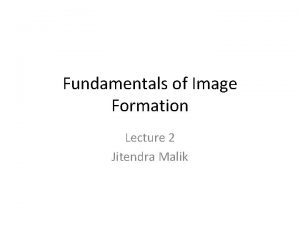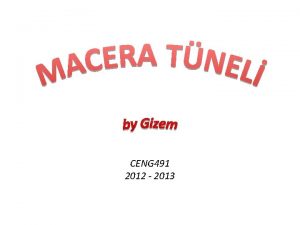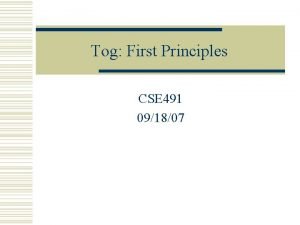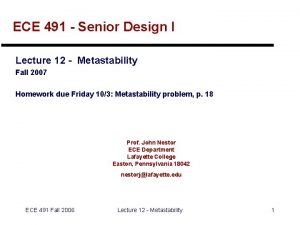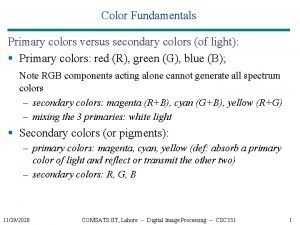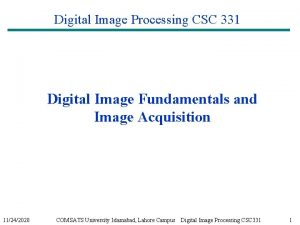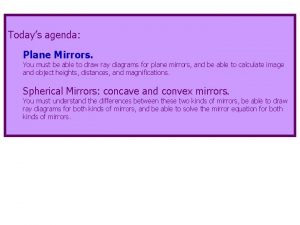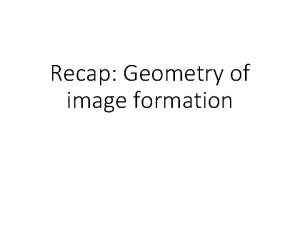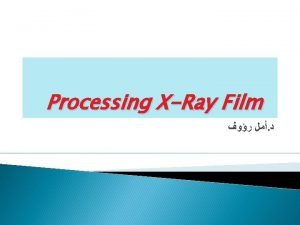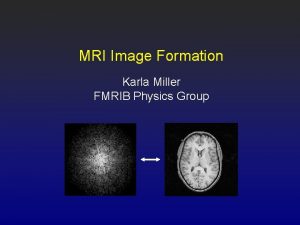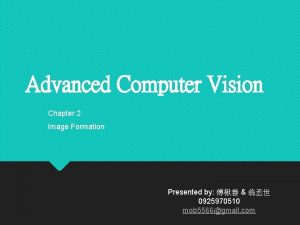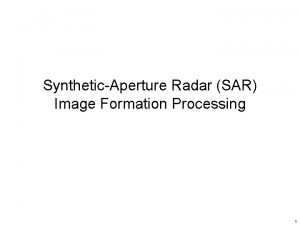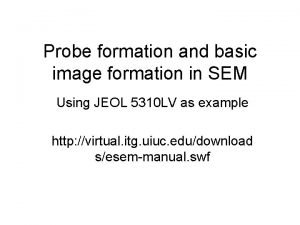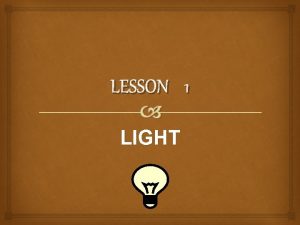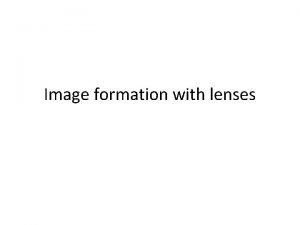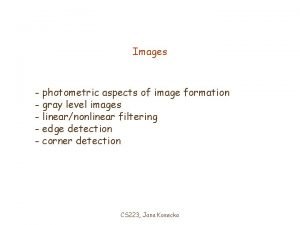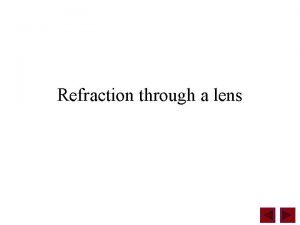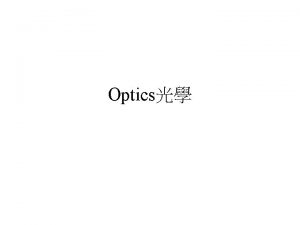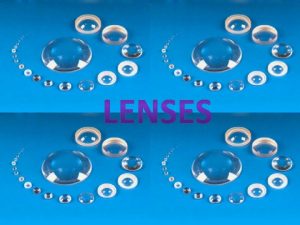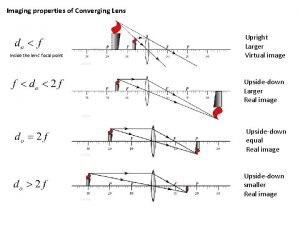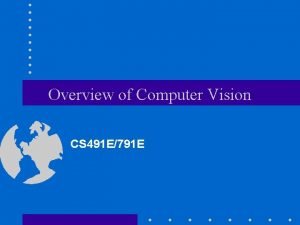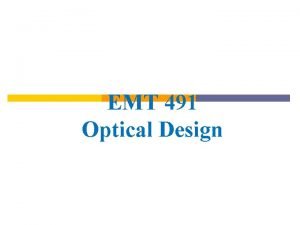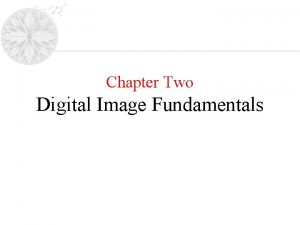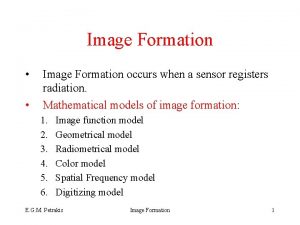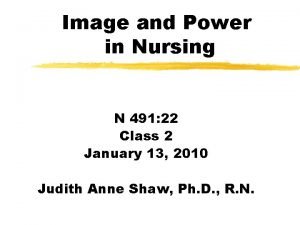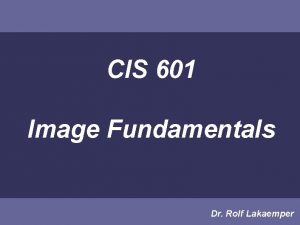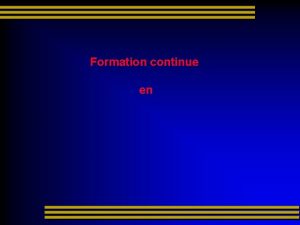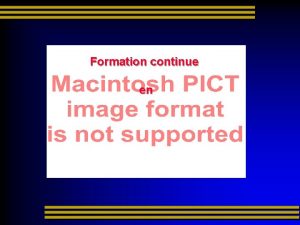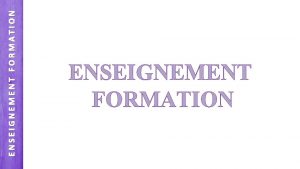Image Formation Fundamentals CS 491 E791 E How




























![An example - Threshold. cpp void read. Image. Header(char[], int&, bool&); void read. Image(char[], An example - Threshold. cpp void read. Image. Header(char[], int&, bool&); void read. Image(char[],](https://slidetodoc.com/presentation_image/4c7c71d0f14e46e655fbe136f9bd2e7d/image-29.jpg)


![Writing a PGM image to a file void write. Image(char fname[], Image. Type& image) Writing a PGM image to a file void write. Image(char fname[], Image. Type& image)](https://slidetodoc.com/presentation_image/4c7c71d0f14e46e655fbe136f9bd2e7d/image-32.jpg)

![Reading a PGM image from a file void read. Image(char fname[], Image. Type& image) Reading a PGM image from a file void read. Image(char fname[], Image. Type& image)](https://slidetodoc.com/presentation_image/4c7c71d0f14e46e655fbe136f9bd2e7d/image-34.jpg)
![Reading a PGM image …. (cont’d) ifp. getline(header, 100, 'n'); while(header[0]=='#') ifp. getline(header, 100, Reading a PGM image …. (cont’d) ifp. getline(header, 100, 'n'); while(header[0]=='#') ifp. getline(header, 100,](https://slidetodoc.com/presentation_image/4c7c71d0f14e46e655fbe136f9bd2e7d/image-35.jpg)






- Slides: 41

Image Formation Fundamentals CS 491 E/791 E

How are images represented the computer? in

Color images

Image formation • There are two parts to the image formation process: – The geometry of image formation, which determines where in the image plane the projection of a point in the scene will be located. – The physics of light, which determines the brightness of a point in the image plane as a function of illumination and surface properties.

A Simple model of image formation • The scene is illuminated by a single source. • The scene reflects radiation towards the camera. • The camera senses it via chemicals on film.

Pinhole camera • This is the simplest device to form an image of a 3 D scene on a 2 D surface. • Straight rays of light pass through a “pinhole” and form an inverted image of the object on the image plane.

Camera optics • In practice, the aperture must be larger to admit more light. • Lenses are placed to in the aperture to focus the bundle of rays from each scene point onto the corresponding point in the image plane

Image formation (cont’d) • Optical parameters of the lens – lens type – focal length – field of view • Photometric parameters – type, intensity, and direction of illumination – reflectance properties of the viewed surfaces • Geometric parameters – type of projections – position and orientation of camera in space – perspective distortions introduced by the imaging process

Image distortion

What is light? • The visible portion of the electromagnetic (EM) spectrum. • It occurs between wavelengths of approximately 400 and 700 nanometers.

Short wavelengths • Different wavelengths of radiation have different properties. • The x-ray region of the spectrum, it carries sufficient energy to penetrate a significant volume or material.

Long wavelengths • Copious quantities of infrared (IR) radiation are emitted from warm objects (e. g. , locate people in total darkness).

Long wavelengths (cont’d) • “Synthetic aperture radar” (SAR) imaging techniques use an artificially generated source of microwaves to probe a scene. • SAR is unaffected by weather conditions and clouds (e. g. , has provided us images of the surface of Venus).

Range images • An array of distances to the objects in the scene. • They can be produced by sonar or by using laser rangefinders.

Sonic images • Produced by the reflection of sound waves off an object. • High sound frequencies are used to improve resolution.

CCD (Charged-Coupled Device) cameras • Tiny solid state cells convert light energy into electrical charge. • The image plane acts as a digital memory that can be read row by a computer.

Frame grabber • Usually, a CCD camera plugs into a computer board (frame grabber). • The frame grabber digitizes the signal and stores it in its memory (frame buffer).

Image digitization • Sampling means measuring the value of an image at a finite number of points. • Quantization is the representation of the measured value at the sampled point by an integer.

Image digitization (cont’d)

Image quantization(example) • 256 gray levels (8 bits/pixel) 32 gray levels (5 bits/pixel) 16 gray levels (4 bits/pixel) • 8 gray levels (3 bits/pixel) 4 gray levels (2 bits/pixel) 2 gray levels (1 bit/pixel)

Image sampling (example) original image sampled by a factor of 4 sampled by a factor of 2 sampled by a factor of 8

Digital image • An image is represented by a rectangular array of integers. • An integer represents the brightness or darkness of the image at that point. • N: # of rows, M: # of columns, Q: # of gray levels – N= , M= , Q= (q is the # of bits/pixel) – Storage requirements: Nx. Mx. Q (e. g. , N=M=1024, q=8, 1 MB)

Image file formats • Many image formats adhere to the simple model shown below (line by line, no breaks between lines). • The header contains at least the width and height of the image. • Most headers begin with a signature or “magic number” - a short sequence of bytes for identifying the file format.

Common image file formats • • • GIF (Graphic Interchange Format) PNG (Portable Network Graphics) JPEG (Joint Photographic Experts Group) TIFF (Tagged Image File Format) PGM (Portable Gray Map) FITS (Flexible Image Transport System)

Comparison of image formats

PGM format • A popular format for grayscale images (8 bits/pixel) • Closely-related formats are: – PBM (Portable Bitmap), for binary images (1 bit/pixel) – PPM (Portable Pixelmap), for color images (24 bits/pixel) • ASCII or binary (raw) storage

ASCII vs Raw format • ASCII format has the following advantages: – Pixel values can be examined or modified very easily using a standard text editor. – Files in raw format cannot be modified in this way since they contain many unprintable characters. • Raw format has the following advantages: – It is much more compact compared to the ASCII format. – Pixel values are coded using only a single character !

Image Class class Image. Type { public: Image. Type(); ~Image. Type(); // more functions. . . private: int N, M, Q; //N: # rows, M: # columns int **pixel. Value; };
![An example Threshold cpp void read Image Headerchar int bool void read Imagechar An example - Threshold. cpp void read. Image. Header(char[], int&, bool&); void read. Image(char[],](https://slidetodoc.com/presentation_image/4c7c71d0f14e46e655fbe136f9bd2e7d/image-29.jpg)
An example - Threshold. cpp void read. Image. Header(char[], int&, bool&); void read. Image(char[], Image. Type&); void write. Image(char[], Image. Type&); void main(int argc, char *argv[]) { int i, j; int M, N, Q; bool type; int val; int thresh; // read image header read. Image. Header(argv[1], N, M, Q, type); // allocate memory for the image array Image. Type image(N, M, Q); // read image read. Image(argv[1], image);

Threshold. cpp (cont’d) cout << "Enter threshold: "; cin >> thresh; // threshold image for(i=0; i<N; i++) for(j=0; j<M; j++) { image. get. Val(i, j, val); if(val < thresh) image. set. Val(i, j, 255); else image. set. Val(i, j, 0); } // write image write. Image(argv[2], image); }

Reading/Writing PGM images
![Writing a PGM image to a file void write Imagechar fname Image Type image Writing a PGM image to a file void write. Image(char fname[], Image. Type& image)](https://slidetodoc.com/presentation_image/4c7c71d0f14e46e655fbe136f9bd2e7d/image-32.jpg)
Writing a PGM image to a file void write. Image(char fname[], Image. Type& image) int N, M, Q; unsigned char *char. Image; ofstream ofp; image. get. Image. Info(N, M, Q); char. Image = (unsigned char *) new unsigned char [M*N]; // convert the integer values to unsigned char int val; for(i=0; i<N; i++) for(j=0; j<M; j++) image. get. Val(i, j, val); char. Image[i*M+j]=(unsigned char)val; }

Writing a PGM image. . . (cont’d) ofp. open(fname, ios: : out); if (!ofp) { cout << "Can't open file: " << fname << endl; exit(1); } ofp << "P 5" << endl; ofp << M << " " << N << endl; ofp << Q << endl; ofp. write( reinterpret_cast<char *>(char. Image), (M*N)*sizeof(unsigned char)); if (ofp. fail()) { cout << "Can't write image " << fname << endl; exit(0); } ofp. close(); }
![Reading a PGM image from a file void read Imagechar fname Image Type image Reading a PGM image from a file void read. Image(char fname[], Image. Type& image)](https://slidetodoc.com/presentation_image/4c7c71d0f14e46e655fbe136f9bd2e7d/image-34.jpg)
Reading a PGM image from a file void read. Image(char fname[], Image. Type& image) { int i, j; int N, M, Q; unsigned char *char. Image; char header [100], *ptr; ifstream ifp; ifp. open(fname, ios: : in); if (!ifp) { cout << "Can't read image: " << fname << endl; exit(1); } // read header ifp. getline(header, 100, 'n'); if ( (header[0]!=80) || /* 'P' */ (header[1]!=53) ) { /* '5' */ cout << "Image " << fname << " is not PGM" << endl; exit(1); }
![Reading a PGM image contd ifp getlineheader 100 n whileheader0 ifp getlineheader 100 Reading a PGM image …. (cont’d) ifp. getline(header, 100, 'n'); while(header[0]=='#') ifp. getline(header, 100,](https://slidetodoc.com/presentation_image/4c7c71d0f14e46e655fbe136f9bd2e7d/image-35.jpg)
Reading a PGM image …. (cont’d) ifp. getline(header, 100, 'n'); while(header[0]=='#') ifp. getline(header, 100, 'n'); M=strtol(header, &ptr, 0); N=atoi(ptr); ifp. getline(header, 100, 'n'); Q=strtol(header, &ptr, 0); char. Image = (unsigned char *) new unsigned char [M*N]; ifp. read( reinterpret_cast<char *>(char. Image), (M*N)*sizeof(unsigned char)); if (ifp. fail()) { cout << "Image " << fname << " has wrong size" << endl; exit(1); } ifp. close();

Reading a PGM image…(cont’d) // // Convert the unsigned characters to integers // int val; for(i=0; i<N; i++) for(j=0; j<M; j++) { val = (int)char. Image[i*M+j]; image. set. Val(i, j, val); } }

How do I “see” images on the computer? • Unix: xv, gimp • Windows: Photoshop

How do I display an image from within my C++ program? • Save the image into a file with a default name (e. g. , tmp. pgm) using the Write. Image function. • Put the following command in your C++ program: system(“xv tmp. pgm”); • This is a system call !! • It passes the command within the quotes to the Unix operating system. • You can execute any Unix command this way ….

How do I convert an image from one format to another? • Use xv’s “save” option • It can also convert images

How do I print an image? • Load the image using “xv” • Save the image in “postscript” format • Print the postscript file (e. g. , lpr -Pname image. ps)

Image processing software • • • CVIPtools (Computer Vision and Image Processing tools) Intel Open Computer Vision Library Microsoft Vision SDL Library Matlab Khoros • For more information, see – http: //www. cs. unr. edu/~bebis/CS 791 E – http: //www. cs. unr. edu/CRCD/Computer. Vision/cv_resources. html
 Fundamentals of image formation
Fundamentals of image formation Fundamentals of image formation
Fundamentals of image formation Digital image processing diagram
Digital image processing diagram Ba491
Ba491 External analysis in strategic management
External analysis in strategic management Pd 491
Pd 491 Cs 491 bilkent
Cs 491 bilkent Bahri tokmak
Bahri tokmak Tog 491
Tog 491 Ece 491
Ece 491 Mtbf formula
Mtbf formula Cse 491
Cse 491 Ece 491
Ece 491 Ece 491
Ece 491 Ee 491
Ee 491 Ee 491
Ee 491 Formation initiale vs formation continue
Formation initiale vs formation continue Fundamentals of image compression
Fundamentals of image compression Color fundamentals in digital image processing
Color fundamentals in digital image processing Digital image processing
Digital image processing What most likely caused the rock formation in the image?
What most likely caused the rock formation in the image? Paraxial
Paraxial Geometry of image formation
Geometry of image formation Latent image formation in radiography
Latent image formation in radiography Image formation in mri
Image formation in mri Jacobs cameras
Jacobs cameras Image formation by concave lens
Image formation by concave lens Factors influencing destination image
Factors influencing destination image Gurney mott theory radiography
Gurney mott theory radiography Geometric and photometric image formation
Geometric and photometric image formation Sar image formation
Sar image formation Sem image formation
Sem image formation Formation of image through narrow holes
Formation of image through narrow holes The principles
The principles Image formation outline
Image formation outline Photometric image formation
Photometric image formation Image formation computer vision
Image formation computer vision Digital image formation
Digital image formation What is lens
What is lens Focal length formula
Focal length formula Image formation by convex lens
Image formation by convex lens Property of converging lens
Property of converging lens
